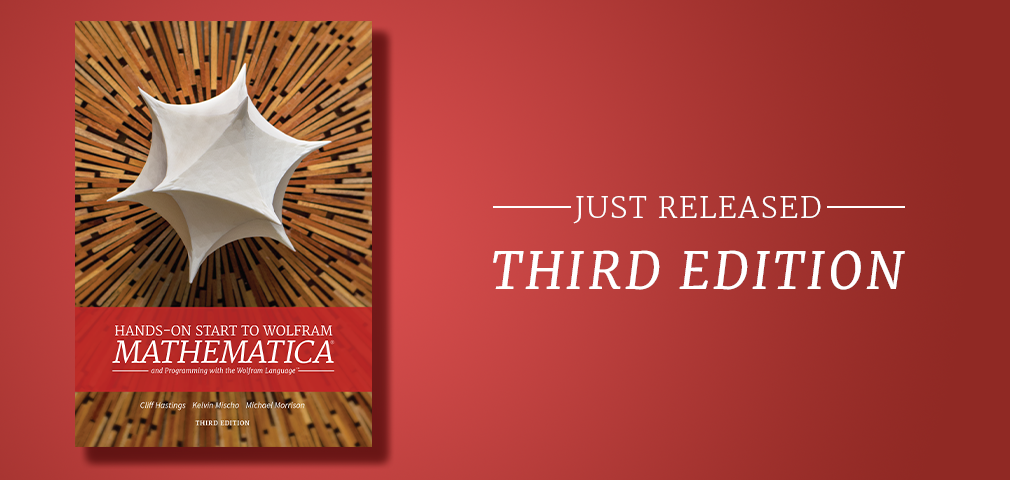Learning and Educating with Hands-on Start to Wolfram Mathematica: Authors Reveal New Edition
September 24 marked the release of the third edition of one of our most successful and widespread teaching tools: Cliff Hastings, Kelvin Mischo and Michael Morrison’s debut book, Hands-on Start to Wolfram Mathematica and Programming with the Wolfram Language. As the publishing assistant at Wolfram Research, I’ve spent the past few weeks working with the authors to get this new version ready to publish. As we did with the second-edition release, I’ll let Cliff and Kelvin tell us a bit about what’s new in the third edition, why Hands-on Start is so successful and what’s on the horizon (Hands-on Start to Wolfram|Alpha Notebook Edition!).
Q: What’s new in the third edition?
A: The third edition of Hands-on Start to Wolfram Mathematica and Programming with the Wolfram Language includes many improvements and refinements to the examples based on the newest version of Mathematica. The chapters on creating slide shows and sharing finished projects have been significantly expanded to outline the newest capabilities in Mathematica. We added three brand-new chapters: “Wolfram|Alpha-Mode Notebooks,” “Machine Learning and Neural Networks” and “Image Processing,” which are all growing areas in Mathematica’s capabilities.
Wolfram|Alpha-Mode is a new type of notebook in Mathematica that is a useful mix of Wolfram|Alpha technology with Wolfram Notebooks. The chapter outlines how to create notebooks with a series of commands, all entered in the Wolfram|Alpha style of everyday English. Time-saving approaches like the system of buttons for related calculations and defining variables or user-defined functions are outlined with sample calculations for the reader to type to gain experience.

Step-by-step solutions, a very popular capability of the Wolfram|Alpha Pro website, are also outlined. Saving a history of step-by-step solutions to either compare answers or keep as an archive for self-learning is a useful aspect of Wolfram|Alpha-Mode Notebooks.

The new chapter on machine learning outlines built-in functions through several examples. The first example introduces both the concept of machine learning and the built-in functions in Mathematica through exploring trends in quiz scores based on imported data. A machine learning classifier is then used to predict likely scores based on new data.


The new chapter on image processing outlines a wide variety of capabilities, ranging from adjusting the resolution of exported images (for websites or publications), to image processing effects, to more involved computation that is a mixture of image processing and machine learning technology.

The built-in functions in Mathematica for color processing or image manipulation, like changing the background of an image, are outlined through simple examples and sample images.

All three chapters outline new potential uses of Mathematica and will hopefully provide the basis for computational ideas that can only be attempted in a language like the Wolfram Language where concise and powerful functions can be used to quickly try new ideas.
Q: How have readers responded to the product since its launch in late 2015?
A: The overall response to the book has been incredibly positive. We regularly receive comments and emails from customers saying that this book has been very helpful on their path toward learning Mathematica and the Wolfram Language. Some readers tell us that they bought the book after first being introduced to Hands-on Start through one of our free online seminars. They find that “the book nicely complemented the course” and that it’s “a great resource for anyone who wants to learn to use the Wolfram software efficiently.”
While the Documentation Center is extremely useful to see examples based on specific functions, the book has a more gradual buildup of materials and complexity. The narrative structure naturally teaches the overall language so readers then fully understand the things they see in the Documentation Center when they jump into other topics. Many readers tell us that they really appreciate Hands-on Start as a sort of stepping stone. It’s a sample of what the technology is capable of; it covers a wide but manageable selection of what Mathematica can do. Readers appreciate the neat print and Kindle formats of the book, with their clear graphics and easy-to-follow guidance as a way to explore what’s available.
Q: Who is the perfect audience for the third edition, and what is the best way to use it?
A: When we wrote the book, we were really focused on the target group of people who have never used Mathematica before and need a resource to learn how to be successful, self-driven users. Students at universities that integrate Mathematica into courses and hobbyists or commercial users who are looking to use Mathematica for a project or specific interest make up the bulk of our readers. Then, over time, there have been two new large groups that we’ve been refining the book for as well: (1) those who have used Mathematica as students but need a deeper understanding of the language outside of what they did to solve homework problems; and (2) those who prefer the conversational approach to teaching over digging through documentation. In this latest edition, we’ve also started considering new users of our software in specific targeted areas like data science, machine learning, etc.
The way that we recommend readers interact with the book is to read it with a computer within reach. Open up a copy of Mathematica—whether it be desktop based or online—and type along. Make a new notebook for each chapter and give the exercises a try. That’s really the way to get the most out of the book.

Q: What’s coming up for the Hands-on Start series?
A: It’s been exciting to see Hands-on Start translated into Korean, in addition to the translations to Japanese and Chinese, and to see the book gain popularity around the world as a result. Of course, we plan to keep doing our video series where users can take virtual classes to learn more about using Mathematica and the Wolfram Language, but we also have plans to bring you another book in the next few weeks. Hands-on Start to Wolfram|Alpha Notebook Edition is coming soon! While Wolfram|Alpha-Mode Notebooks will be a useful addition for Mathematica users, this separate book focuses on the Wolfram|Alpha Notebook Edition product, which is a completely separate product that follows the same idea of giving users a simple way to enter calculations in everyday English while also being able to use the flexible notebook format.
Now Available from Wolfram Media
Thank you again to the authors for taking time to answer some questions about this new edition. Hands-on Start to Wolfram Mathematica and Programming with the Wolfram Language, updated for Version 12 with three new chapters, is available from Wolfram’s web store. It’s also available on Amazon in print and digital formats. If you’re interested in using the book as a textbook or in doing a translation, contact us at Wolfram Media.
Looking for more from Hands-on Start?
|





Comments